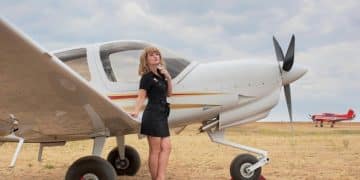FAA Regulations 2025: Impact on Travel Blogger Earnings

The new FAA regulations in 2025 are expected to significantly impact travel blogger earnings by changing drone usage restrictions, potentially increasing operational costs and limiting content creation opportunities.
As we approach 2025, travel bloggers are keenly watching for changes that could affect their income. The most watched news is how will the new FAA regulations impact travel blogger earnings in 2025?, a question that weighs heavily on the minds of content creators who rely on aerial footage and travel-related content.
Understanding the Current FAA Regulations
To fully grasp the forthcoming changes, it’s essential to understand the regulations currently in place. These rules dictate how, when, and where drones can be flown for commercial purposes, directly affecting travel bloggers’ ability to capture stunning visuals.
The Federal Aviation Administration (FAA) oversees drone operations in the United States, establishing rules that dictate various aspects of drone usage, including registration, pilot certification, and operational limitations. These regulations are designed to ensure the safety of the national airspace while accommodating the growing popularity of unmanned aircraft systems (UAS).
Key Existing Regulations
The current FAA regulations cover several critical areas that impact travel bloggers. Understanding these existing rules is crucial for anticipating the changes coming in 2025.
- Registration Requirements: All drones weighing over 0.55 pounds (250 grams) must be registered with the FAA. This registration helps the FAA track drones and their operators, promoting accountability.
- Pilot Certification: Commercial drone operators, including travel bloggers who use drones to create content for profit, must obtain a Part 107 Remote Pilot Certificate. This certification requires passing an aeronautical knowledge test and adhering to FAA regulations.
- Operational Restrictions: Drones are subject to numerous operational restrictions, including limitations on altitude (typically 400 feet above ground level), maintaining visual line of sight with the drone, and restrictions on flying over people.
The current regulatory landscape significantly influences how travel bloggers operate, impacting their ability to capture unique content. Compliance with these regulations is not only a legal requirement but also essential for maintaining a professional reputation and avoiding penalties.

Anticipated Changes in the FAA Regulations for 2025
Looking ahead to 2025, several changes are anticipated in FAA regulations that could have significant implications for travel bloggers. These changes are designed to address emerging technologies, enhance safety, and further integrate drones into the national airspace.
The FAA is continuously working to update its regulations to keep pace with technological advancements and address new challenges. Several key areas are expected to undergo changes in 2025.
Remote ID Requirements
One of the most significant anticipated changes is the full implementation of Remote ID requirements. This rule mandates that all drones broadcast identification and location information, allowing them to be identified remotely. Compliance with Remote ID is essential for all drone operators, including travel bloggers.
Expanded Operational Waivers
The FAA is expected to offer expanded operational waivers, allowing drone operators to conduct operations that are currently restricted. These waivers could include permissions for beyond visual line of sight (BVLOS) operations, nighttime flights, and flights over people, providing more flexibility for travel bloggers.
- BVLOS Operations: Waivers for BVLOS operations would allow travel bloggers to capture footage from more distant locations, opening up new possibilities for capturing unique perspectives.
- Nighttime Flights: Permission for nighttime flights could enable travel bloggers to capture stunning nocturnal landscapes and cityscapes.
- Flights Over People: Waivers for flights over people would allow travel bloggers to capture footage in crowded areas, providing opportunities to showcase vibrant cultural events and urban environments.
The implementation of Remote ID and the availability of expanded operational waivers could reshape how travel bloggers use drones, potentially increasing their operational capabilities and creative options. However, compliance with these new regulations is essential for legal and safe drone operations.
How These Changes Could Affect Travel Blogger Earnings
The anticipated changes in FAA regulations could significantly impact travel blogger earnings, both positively and negatively. Understanding these potential impacts is crucial for travel bloggers to adapt their business strategies and remain competitive.
The evolving regulatory landscape presents both challenges and opportunities for travel bloggers. The impact on earnings will depend on how effectively bloggers can navigate these changes.
Potential Positive Effects
Expanded operational waivers could create new revenue streams for travel bloggers by enabling them to capture more diverse and compelling content. The enhanced flexibility offered by these waivers could attract more viewers and sponsors.
- Increased Content Quality: BVLOS operations and nighttime flights could enable travel bloggers to capture visually stunning content that differentiates them from competitors.
- Greater Flexibility: The ability to fly over people could open up opportunities to capture unique footage of events and urban landscapes.
- Attracting Sponsors: Higher-quality and more diverse content could attract more sponsors and brand partnerships, increasing revenue for travel bloggers.
Potential Negative Effects
New compliance costs associated with Remote ID and other regulatory requirements could reduce travel blogger earnings. Additionally, some travel bloggers may struggle to adapt to the new regulations, potentially limiting their operational capabilities.
The increased complexity and cost of compliance are significant concerns for travel bloggers. Keeping up with the changing regulations requires time, effort, and financial resources.
- Compliance Costs: Implementing Remote ID technology and obtaining necessary waivers could involve significant costs, including the purchase of new equipment and software.
- Operational Limitations: Some travel bloggers may find it challenging to comply with the new regulations, particularly those operating in remote or challenging environments.
- Increased Competition: As drone technology becomes more accessible, increased competition could drive down prices and reduce earnings for travel bloggers.
The changes in FAA regulations are expected to bring both opportunities and challenges for travel bloggers. Those who can adapt quickly and effectively may see their earnings increase, while those who struggle to comply may face reduced revenue.

Strategies for Travel Bloggers to Adapt and Thrive
To navigate the changing regulatory landscape, travel bloggers need to adopt proactive strategies to adapt and thrive. These strategies include staying informed about regulatory changes, investing in training and compliance, and diversifying revenue streams.
Success in the face of evolving FAA regulations requires a combination of knowledge, preparation, and adaptability. Travel bloggers who take these steps are more likely to maintain and grow their earnings.
Staying Informed
Keeping up-to-date with the latest FAA regulations and industry news is crucial for travel bloggers. Regularly checking the FAA website, attending industry events, and subscribing to relevant newsletters can help travel bloggers stay informed about regulatory changes.
Investing in Training and Compliance
Travel bloggers should invest in training and compliance programs to ensure they meet all regulatory requirements. This includes obtaining necessary certifications, understanding Remote ID requirements, and implementing best practices for safe drone operations. Partnering with legal and compliance experts can also provide valuable support.
Diversifying Revenue Streams
Relying solely on drone footage for revenue can be risky, given the uncertainties of regulatory changes. Travel bloggers should diversify their revenue streams by offering a range of services, such as sponsored content, affiliate marketing, and consulting. This diversification can help mitigate the impact of regulatory changes on their earnings.
Case Studies of Travel Bloggers and FAA Compliance
Examining real-world examples of travel bloggers navigating FAA regulations can provide valuable insights. These case studies illustrate how different bloggers have adapted to regulatory changes and the strategies they have employed to remain successful.
These examples highlight the importance of compliance, adaptability, and diversification in maintaining successful travel blogs in the face of evolving FAA regulations.
Case Study 1: Successful Drone Operator
One travel blogger has successfully integrated drone footage into their content while maintaining full compliance with FAA regulations. This blogger invested in a Part 107 Remote Pilot Certificate, implemented Remote ID technology, and consistently adheres to operational restrictions. The result is high-quality content that attracts sponsors and generates revenue.
Case Study 2: Overcoming Regulatory Challenges
Another travel blogger faced challenges in complying with FAA regulations due to operating in remote areas with limited connectivity. This blogger invested in satellite-based Remote ID solutions and obtained necessary waivers to conduct BVLOS operations safely. By overcoming these challenges, the blogger has continued to capture unique footage and maintain their audience.
Case Study 3: Diversification Strategies
A third travel blogger diversified their revenue streams to mitigate the impact of regulatory changes on their earnings. In addition to drone footage, this blogger offers sponsored content, affiliate marketing, and consulting services. This diversification strategy has helped stabilize their income and reduce their reliance on drone-related revenue.
Future Trends and Predictions for Travel Blogging
Looking ahead, several key trends and predictions are shaping the future of travel blogging. These include advancements in drone technology, changes in consumer preferences, and the ongoing evolution of FAA regulations.
Staying abreast of these trends and predictions is essential for travel bloggers to remain competitive, adapt to changing market conditions, and capitalize on emerging opportunities.
- Advancements in Drone Technology: Expect advancements in drone technology to continue, including improved battery life, enhanced camera capabilities, and more sophisticated navigation systems. These advancements will enable travel bloggers to capture even more impressive footage.
- Changes in Consumer Preferences: Consumer preferences are evolving, with audiences increasingly seeking authentic and immersive travel experiences. Travel bloggers who can deliver engaging content that resonates with these preferences are more likely to succeed.
- Ongoing Evolution of FAA Regulations: The FAA is expected to continue updating its regulations to keep pace with technological advancements and address emerging challenges. Travel bloggers should remain informed about these changes and adapt their operations accordingly.
| Key Aspect | Brief Description |
|---|---|
| 🔑 FAA Regulations | Governing the operation of drones and impacting content creation. |
| 💰 Travel Blogger Earnings | Influenced by compliance costs and content opportunities. |
| 📈 Adaptation Strategies | Staying informed, investing in training, and diversifying revenue. |
| 💡 Future Trends | Drone tech, changing preferences, and regulation evolution. |
Frequently Asked Questions about FAA Regulations
The Part 107 Remote Pilot Certificate is required for commercial drone operators in the United States. Obtaining this certificate involves passing an aeronautical knowledge test and complying with FAA regulations, ensuring safe drone operations.
Remote ID requirements mandate that all drones broadcast identification and location information, enabling them to be identified remotely. This helps the FAA track drones and promotes accountability, enhancing safety in the national airspace.
Travel bloggers can apply for operational waivers from the FAA to conduct operations that are currently restricted. These waivers may include permissions for BVLOS operations, nighttime flights, and flights over people, providing more flexibility.
The costs associated with FAA compliance can vary but may include expenses for obtaining a Part 107 Remote Pilot Certificate, implementing Remote ID technology, and purchasing necessary equipment and software. These costs can impact travel blogger earnings.
Diversifying revenue streams is important for travel bloggers to mitigate the impact of regulatory changes on their earnings. By offering services like sponsored content and affiliate marketing, they can reduce their reliance on drone-related revenue.
Conclusion
In conclusion, travel bloggers face a dynamic regulatory environment in 2025. While the new FAA regulations may present challenges, understanding and adapting to these changes can lead to new opportunities and revenue streams. Staying informed, investing in compliance, and diversifying income will be key to success.





